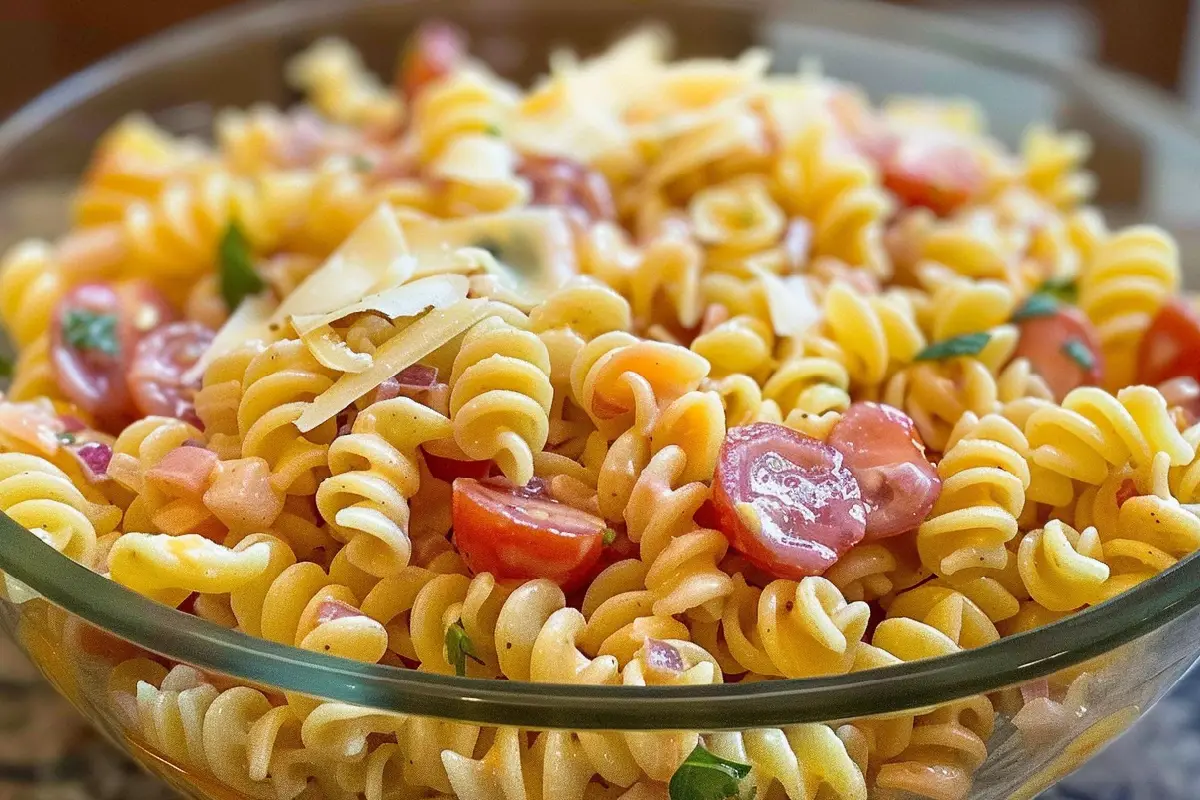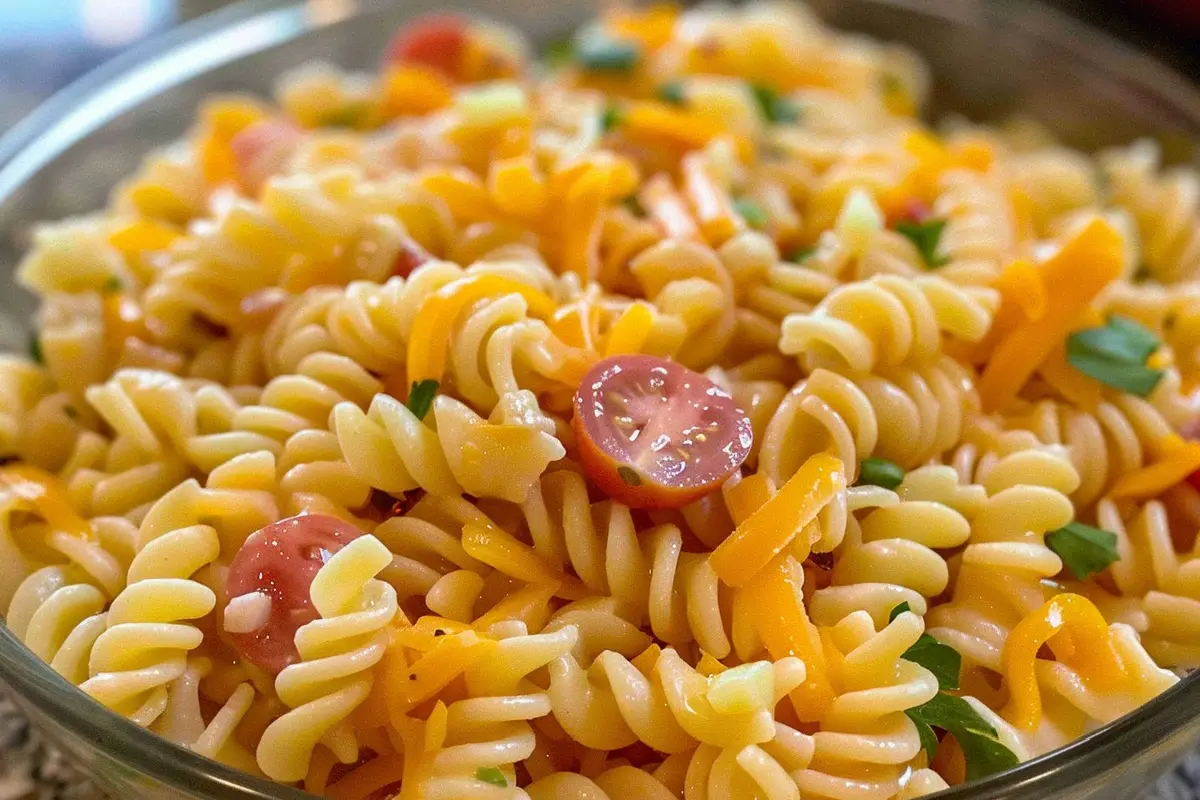Introduction to What Are The Five Mistakes To Avoid Pasta Salad?
Pasta salad is a staple dish at summer barbecues, picnics, and even as a light meal on busy weekdays. While it might seem like a straightforward recipe, making a truly delicious pasta salad can be challenging if you’re not aware of the most common pitfalls. With so many variables—pasta types, dressings, and ingredient combinations—it’s easy to make mistakes that turn your dish into a bland, soggy mess. Let’s discover What Are The Five Mistakes To Avoid Pasta Salad?
In this article, we’ll cover the five most common mistakes that can ruin your pasta salad, provide expert tips, and include alternative suggestions to elevate your pasta salad to the next level. Let’s ensure that your pasta salad becomes the star of any gathering.
Mistake #1: Choosing the Wrong Type of Pasta
The type of pasta you choose is one of the most important elements in determining the texture and flavor distribution of your salad. Using the wrong pasta shape can cause your salad to turn out clumpy, soggy, or simply unable to hold the dressing well.
Why Pasta Shape Matters
Pasta comes in a wide variety of shapes and textures, each with a specific purpose. In pasta salad, the goal is to choose a pasta that grips the dressing and holds up under mixing. Thin pasta, like spaghetti or angel hair, tends to clump together and doesn’t provide enough surface area for the dressing to adhere.
- Best pasta shapes for pasta salad include fusilli, rotini, penne, and farfalle. These types have ridges and crevices that trap the dressing, ensuring every bite is flavorful.
- Avoid long, thin pasta that will stick together, such as linguine or fettuccine. These types are better suited for hot dishes with thick sauces.
Cooking Tips for the Best Texture
- Cook pasta until al dente. This means it should be firm to the bite but not crunchy. Al dente pasta holds its shape better and does not become mushy after absorbing the dressing.
- After draining, rinse the pasta briefly with cold water to stop the cooking process and remove excess starch. This step is crucial in keeping the pasta from sticking.
Suggested Internal Link: Learn more about selecting and cooking pasta in our Marry Me Chicken Recipe with Pasta for tips on achieving perfect pasta texture.
Mistake #2: Overcooking or Undercooking the Pasta

If your pasta is overcooked, your salad will turn into a mushy, soggy mess. If undercooked, it will be chewy and difficult to enjoy. Achieving the right balance is key.
How to Get the Perfect Cook
- Start by boiling pasta in salted water—about 1 tablespoon of salt per gallon of water. This step seasons the pasta from the inside out.
- Test the pasta 1-2 minutes before the suggested cooking time on the package. Al dente pasta should have a firm bite but no raw taste.
- Once cooked, shock the pasta in ice water or rinse under cold running water to stop the cooking process. This prevents it from becoming mushy in the salad.
For a step-by-step guide to cooking pasta perfectly, check out How to Boil Pasta Al Dente.
Mistake #3: Adding Too Many Ingredients
One of the biggest mistakes when making pasta salad is overloading it with ingredients. A well-made pasta salad should have balanced flavors, but adding too many items can overwhelm your taste buds and make it hard to appreciate the subtlety of individual flavors.
Choosing the Right Ingredients
- Select 3-5 key ingredients that complement each other. For example, use cherry tomatoes, cucumbers, red onions, and olives for a Mediterranean twist.
- Add one or two proteins, like grilled chicken, tuna, or cubed cheese, to give your salad heft and satisfying texture.
- Consider seasonal ingredients. In summer, use fresh herbs like basil, mint, and parsley. In cooler months, add roasted vegetables or root veggies for a more robust flavor.
Balancing Texture and Flavor
- For crunch, add items like bell peppers or celery. For creaminess, mix in a little feta cheese or avocado.
- Keep the dressing simple—a basic vinaigrette of olive oil, vinegar, garlic, and mustard is a good starting point. This allows the individual ingredients to shine.
Learn more about ingredient balance in our 4-Ingredient Pasta Salad Guide.
Mistake #4: Not Seasoning the Salad Properly
A common mistake is under-seasoning the pasta salad. Bland pasta salad is disappointing, and the problem often starts with forgetting to season each layer of the salad.
How to Properly Season a Pasta Salad
- Salt the pasta water generously. Pasta absorbs salt as it cooks, enhancing its flavor.
- Season each ingredient as you add it to the salad—add a pinch of salt to chopped veggies, pepper to proteins, and a dash of herbs to the dressing.
- Mix the dressing separately, using a combination of acidic and fatty elements. For instance, use balsamic vinegar with olive oil, a squeeze of lemon juice, and a bit of honey for sweetness.
Building a Flavorful Dressing
- Use bold flavors like garlic, Dijon mustard, and crushed red pepper to kick up the taste.
- Consider adding fresh herbs, such as oregano, thyme, or basil, to your dressing.
- If you prefer a creamy dressing, mix Greek yogurt or mayonnaise with lemon juice, dill, and a splash of white wine vinegar for a tangy, rich flavor.
For additional dressing ideas, check out Tangy Deviled Eggs with Relish Recipe for creative vinaigrette and creamy dressing combinations.
Mistake #5: Dressing the Salad Too Early
Dressing pasta salad too early is a common problem that results in soggy pasta and diluted flavors. Pasta tends to absorb liquid over time, making it essential to time your dressing correctly.
When to Dress Pasta Salad
- For immediate serving, toss the salad 30 minutes before eating. This allows the flavors to meld without making the pasta too soft.
- If making ahead, keep the dressing separate and mix it in just before serving. You can also add a few tablespoons of the dressing when prepping and reserve the rest to freshen up the salad later.
How to Store and Revive Pasta Salad
- Refrigerate pasta salad in an airtight container to keep it fresh.
- If the salad dries out, add a little olive oil or a splash of lemon juice to revive it.
For more tips on storing and serving, read our article on What is a 4-Ingredient Pasta Salad?.
Bonus Tips for Making the Perfect Pasta Salad
To ensure your pasta salad is a showstopper, consider these additional tips:
1. Use High-Quality Ingredients
The quality of ingredients can make a huge difference. Choose high-quality olive oil, fresh produce, and artisan cheeses whenever possible.
2. Let the Flavors Marinate
For the best results, let the salad sit for 20-30 minutes after dressing to let the flavors develop. If making it ahead, allow the salad to come to room temperature before serving for a more robust flavor.
3. Try Different Flavor Profiles
Don’t limit yourself to traditional Italian flavors. Explore Asian-inspired pasta salads with sesame oil, soy sauce, and ginger. Try a Mexican twist with cilantro, lime, and avocado.
FAQs About What Are The Five Mistakes To Avoid Pasta Salad?
Q1: Can I make pasta salad gluten-free?
Yes, you can easily make a gluten-free pasta salad! Opt for gluten-free pasta varieties made from rice, quinoa, chickpea, or lentils. These pasta types provide a similar texture and flavor to traditional wheat pasta, but without gluten. Just be cautious when cooking as gluten-free pasta can sometimes have a different cooking time and may become mushy faster. Pair your gluten-free pasta with naturally gluten-free ingredients such as fresh vegetables, proteins like chicken or tofu, and a homemade gluten-free dressing.
Q2: What can I use instead of mayonnaise?
If you want to skip mayonnaise, there are plenty of lighter options that add creaminess without the added fat. Use Greek yogurt, hummus, or mashed avocado for a creamy texture. Another great option is a tahini-based dressing, which provides a nutty, rich flavor without any dairy. These alternatives are not only healthier but also add their own distinct flavor profiles to the salad. You can even experiment with a cashew cream dressing by blending soaked cashews with lemon juice and nutritional yeast for a vegan option.
Q3: How can I add more protein to my pasta salad?
To make your pasta salad more filling and protein-rich, add proteins like grilled chicken, sliced steak, shrimp, or smoked salmon. Vegetarian options include cubed tofu, tempeh, or hard-boiled eggs. For a plant-based protein boost, consider adding chickpeas, kidney beans, or edamame. These ingredients not only provide protein but also complement a variety of pasta salad styles, making your salad more substantial and satisfying.
Q4: Can pasta salad be served warm?
Yes, pasta salad doesn’t always have to be served cold. Serving your pasta salad warm can bring out different flavors, especially if you’re using roasted vegetables, grains, and heartier proteins like grilled chicken or steak. Warm pasta salads pair well with hearty dressings like balsamic glaze, pesto, or a butter-based sauce. Simply toss freshly cooked pasta with your ingredients and serve immediately for a comforting and flavorful dish. Try serving a warm pasta salad in colder months to provide a more comforting meal.
Q5: What are some dairy-free dressing options?
If you need a dairy-free option, vinaigrettes are a great base for pasta salads. Start with olive oil and vinegar or lemon juice, and then add mustard, herbs, and spices. Other great alternatives include avocado-based dressings or tahini dressings. For a creamier texture, blend silken tofu with herbs and lemon juice. You can also use nut butters like almond butter mixed with lemon juice and olive oil. If you want a hint of sweetness, try coconut milk blended with lime and cilantro. These options provide a rich flavor without using dairy, making them perfect for vegans or anyone with lactose intolerance.
Conclusion: What Are The Five Mistakes To Avoid Pasta Salad?

By avoiding these common mistakes, you can transform your pasta salad into a dish that’s bursting with flavor, perfectly textured, and guaranteed to impress. Remember to choose the right pasta, season properly, and add the dressing at the right time. Now that you know how to create the perfect pasta salad, it’s time to get creative and experiment with new flavors. For more recipes and inspiration, visit Crystal Recipes to explore a world of delicious options!
This comprehensive guide ensures you’ll have all the tools and knowledge needed to master pasta salad for any occasion. Enjoy your cooking and happy experimenting!

